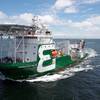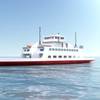Krill Systems Inc. said it has completed its phase 2 product development cycle with the recently introduced Krill Regasification Monitoring Center (KRMC).
Krill identified this phase of its business plan as the ability to supply a comprehensive range of energy monitoring products which deliver solutions to many the aspects demanded by the oil and gas industry to control energy operating costs.
In phase 1, Krill said its focus was on developing Vessel Fuel Management Systems (VFMS) with high accuracy, reliability and features demanded by professional offshore and on shore commercial operators. The basic VFMS system was further developed, in phase 1, with the addition of: Vessel Operation Center (VOC) for remote fleet monitoring and analysis: Automatic Dynamic Positioning mode monitoring: Boundary ‘fencing’ capability: Onboard bunkering monitoring and reporting, and a broad range (12”, 15”, 19”, 23”) of ABS-class display monitor/processer combinations, which set the Krill VFMS technically ahead of its time and the system preferred by most experienced professional operators.
Krill’s phase 2 development plan envisioned an expanded product basket focused on the onboard/onshore and regulatory aspects of the business, including: comprehensive bunker tracking, emissions control, and liquefied natural gas (LNG) regasification.
Bunker Tracking: It is important in today’s environment to track and secure valuable fuel assets, particularly where fuel is being transferred in multiple steps. Accurate real time monitoring at every point of transfer is important to prevent fuel loss. A typical series of transfers may include: Transfer of fuel between a vessel and an oil platform: Transfer of fuel from the vessel to dockside storage tanks: Transfer from dockside storage tanks to a truck or train distribution network. There are many combinations in this fuel transfer chain, all of which need to be closely monitored if fuel assets are to be protected. The Krill DBPM software, with its ability to monitor up to eight simultaneous transfers, now offers an excellent solution to this problem.
Emissions Monitoring: With increasing global focus on emission reduction and control, from many different sources, tightening international and national regulations on emissions from ships are gradually being implemented. Complying with regulations is a driving force for every operation involving combustion processes. To achieve compliance with environmental regulations, extensive development resources are being allocated by vessel owners to the development of emission reduction and continuous emission monitoring solutions for gasses including NOx, SOx, CO2, PM and other polluting media. Krill is now able to offer a total solution which, thanks to the modular design of our monitoring system, can also be customized to meet specific client requirements, with fully compliant IMO resolution MEPC. 259(68). The system has achieved marine type approval by DNV/GL, RINA and Bureau Veritas.
Regasification: Regasification involves the use of a specialized Regasification Unit, which regasifies liquid LNG (typically imported via LNG tankers) to a natural gas pipeline grid. A regasification unit may be based on land or on a vessel (FSRU) permanently moored near a gas pipeline. The regasification process is complex. Every part of the system requires careful monitoring both in terms of its own integrity and in relation to changes in all other parts of the system, mainly the result of fluctuating grid demand, to ensure efficient processing and optimized cost savings. The Krill Regasification Monitoring Center (KRMC) provides real time data monitoring of the entire LNG regasification process. Presented on a series of easily accessed menu-driven display screens, the data collected by the KRMC delivers all the information necessary for the LNG manager to accurately monitor the entire LNG regasification process including system status, system health and system efficiency. The Krill KRMC is designed for use in both land-based and marine applications. Using Microsoft SQL server database technology to record all sensor data on board, with 15-second resolution and storage capacity of over one year, the collected data is displayed onboard and the onboard database, with the collected sensor data, is copied and synchronized with a centralized Microsoft Azure cloud-based database server. This replicates the onboard data display monitor, thereby delivering unlimited number of onshore managers with a complete overview of system operation, its health and its efficiency. The data transfer operates continuously in real time.










